| |
The following materials are required for use throughout the class.
 |
|
 |
| |
Paper:
- Pad of newsprint 18" x 24"
- Pad of drawing or sketch paper 18" x 24"
- At least three sheets of heavy drawing paper (drawing paper with a tooth) such as from Canson, BFK, or Arches brands. A color sheet is optional. 18" x24"
Media:
- Vine or willow charcoal sticks (medium hardness)
- At least three graphite HB pencils
- Chalk pastels (the more colors the better, including white)
- Kneaded eraser
Setup and finishing materials:
- Drawing board
- Masking tape or artist tape
- Spray fixative
- X-Acto blade
|
|
 |
|
 |
Item Descriptions
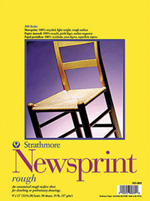 | Newsprint is a cheaper, often slightly gray paper. Its affordability makes it appealing to use when doing preliminary sketches or warm-up exercises. However, newsprint is not very archival; it tends to yellow and become brittle when exposed to the elements and direct sunlight for too long. |
|
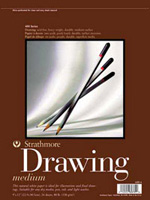 |
For charcoal drawings, you will either be using your newsprint or a heavier drawing paper with a tooth that is good for working with charcoal.
The tooth refers to the texture of the paper. Paper can be very smooth, and have very little tooth, or very rough with greater tooth for capturing drawing materials. Paper with more tooth may be easier to make deep marks on but will also be more difficult to erase.
I recommend a drawing paper with a medium weight: 80-120 lb. paper. The weight refers to the amount of the pressure placed on the paper during its fabrication to make it flat. |
|
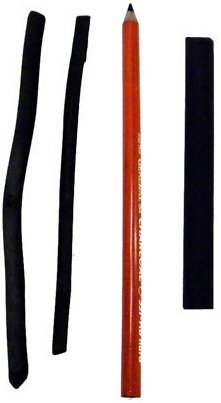 | Charcoal comes in a variety of forms such as sticks, pencils, and compressed blocks to create marks of different values: softer for darker lines, and harder for lighter, sharper lines.
You can use either vine or willow charcoal sticks. Each type has different qualities. In my opinion, vine charcoal sticks to the paper better, but willow charcoal is more fluid and easier to use. I prefer the willow charcoal for its rich, dark tones. I just need to be careful where I rest my hand and spray-fix my drawing when I'm done to avoid unwanted smudges or smearing. |
|
 |
The kneaded eraser can be shaped to make different marks. You can make thin and wide marks depending upon how you shape the eraser. Tear off little pieces to make thin and controlled lines. I find it gives me greater control over the mark. |
|
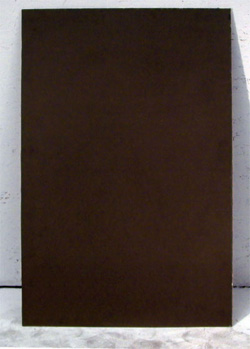 |
You will also find it useful to lean on a drawing board when working. A drawing board is a smooth piece of wood, not much larger than your drawing paper and typically made of hardboard. You can purchase a drawing board at an art store that may have clips for holding your paper attached.
I find using a piece of hardboard found at a hardware store works just as well and may be cheaper.
It is important that you work on a drawing board or some other surface other than your pad of paper as you may make marks that will indent the pages below, making unnecessary and unwanted marks in future drawings. |
|
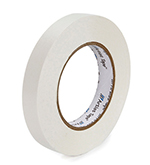 |
You will be using masking tape to secure your paper on your drawing board. There is a special type of masking tape called artist tape. Strathmore is a recommended brand of artist tape.
Artist tape is a better quality than the masking tape you would find in a hardware store. It is often white or blue in color. Artist tape is easier to lift off your paper without tearing.
If you can afford it, I would recommend the artist tape; if not, any masking tape will do. When taping your drawing to your drawing board, it isn't necessary to use a lot of tape, just enough to secure your drawing. |
|
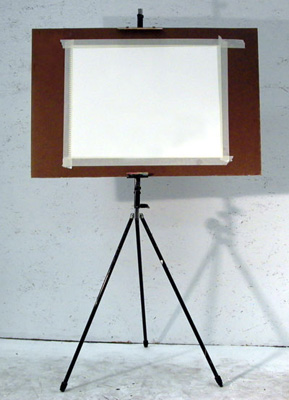 |
Note: An easel is not required.
If you can afford it, I suggest purchasing an easel to use for this course. Several different types of easels are available on the market. I would recommend a small, portable, metal easel. These are very useful and can be set up almost anywhere. Don't feel you need to spend a lot of money when purchasing an easel, but do get your money's worth. Thin, cheap easels tend to fall over and break very easily.
It's all right if you don't have an easel. Just make sure that your drawing board is well supported. You could sit on your bed and prop your board against the wall or with some pillows or even try using another chair. |
Additional Materials
The following materials are required for specific project options. For more detail, see Exercise Four and Exercise Six.
In Exercise Four, you will choose to create two projects from these three choices: graphite drawing, mixed materials drawing, ink wash drawing. You must have materials for two of these three projects:
 |
|
 |
| |
- Graphite drawing: HB graphite pencil, X-Acto blade
- Mixed materials drawing: Vine or willow charcoal, compressed charcoal, white conté crayon or pencil, HB charcoal pencil (optional), 6B charcoal pencil (optional), spray fixative
- Ink wash drawing: India ink, mixing tray, two small containers of water, bamboo brush, watercolor paper or rag paper, paper towel
|
|
 |
|
 |
In Exercise Six, you will choose to create a drawing from a photograph, a photomontage, or an abstract expressionist series. You must have materials for one of these three projects:
 |
|
 |
| |
- Drawing from photographs: Drawing paper, HB pencils (additional softer and harder pencils are optional), ruler, kneaded eraser, photograph source (black and white is preferable)
- Photomontage: Magazines, newspapers, snapshots to cut up, heavy paper such as card stock or watercolor paper, glue stick or Elmer's Glue, scissors or an X-Acto blade
- Abstract work: Large drawing paper or newsprint, charcoal or other drawing material of your choice
|
|
 |
|
 |
|

